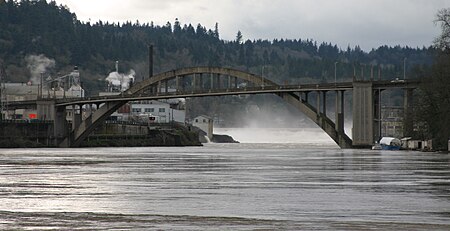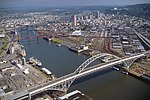Course of the Willamette River

The Willamette River is a 187-mile (301 km) tributary of the Columbia River in the U.S. state of Oregon. The upper tributaries of the Willamette originate in mountains south and southeast of the twin cities of Eugene and Springfield. Formed by the confluence of the Middle Fork Willamette River and Coast Fork Willamette River near Springfield, the main stem meanders generally north from source to mouth. The river's two most significant course deviations occur at Newberg, where the stream turns sharply east, and about 18 miles (29 km) downriver from Newberg, where it turns north again. Near its mouth, the river splits into two channels that flow around Sauvie Island. The main channel enters the Columbia about 101 miles (163 km) from the larger stream's mouth on the Pacific Ocean, and the smaller Multnomah Channel enters the Columbia about 14.5 miles (23.3 km) further downstream near St. Helens in Columbia County. Incorporated Cities along the Willamette's course include Springfield and Eugene in Lane County; Harrisburg in Linn County; Corvallis in Benton County; Albany in Linn and Benton counties; Independence in Polk County; Salem in Marion and Polk Counties; Keizer in Marion County; Newberg in Yamhill County; Oregon City, West Linn, Milwaukie, and Lake Oswego in Clackamas County (Small portions of the later two extend into Multnomah County), and Portland in Multnomah County. (Parts of Portland are also in Washington County, but the Willamette neven makes contact with Washington County.) Significant tributaries include the McKenzie, Long Tom, Marys, Calapooia, Santiam, Luckiamute, Yamhill, Molalla, Tualatin, and Clackamas rivers. Arising at 438 feet (134 m) above sea level, the river loses 428 feet (130 m) in elevation between source and mouth or about 2.3 feet per mile (43 cm per km). The gradient is slightly steeper from the source to Albany than from Albany to Oregon City. At Willamette Falls, the river plunges about 40 feet (12 m). For the rest of its course, the river is extremely low-gradient and is influenced by Pacific Ocean tidal effects from the Columbia. The main stem of the Willamette varies in width from about 330 to 660 feet (100 to 200 m).
Excerpt from the Wikipedia article Course of the Willamette River (License: CC BY-SA 3.0, Authors, Images).Course of the Willamette River
Kelley Point Park Trail, Portland Saint Johns
Geographical coordinates (GPS) Address Nearby Places Show on map
Geographical coordinates (GPS)
| Latitude | Longitude |
|---|---|
| N 45.652777777778 ° | E -122.76472222222 ° |
Address
Kelley Point Park Trail (Kelley Point Park Path)
Kelley Point Park Trail
Portland, Saint Johns
Oregon, United States
Open on Google Maps









